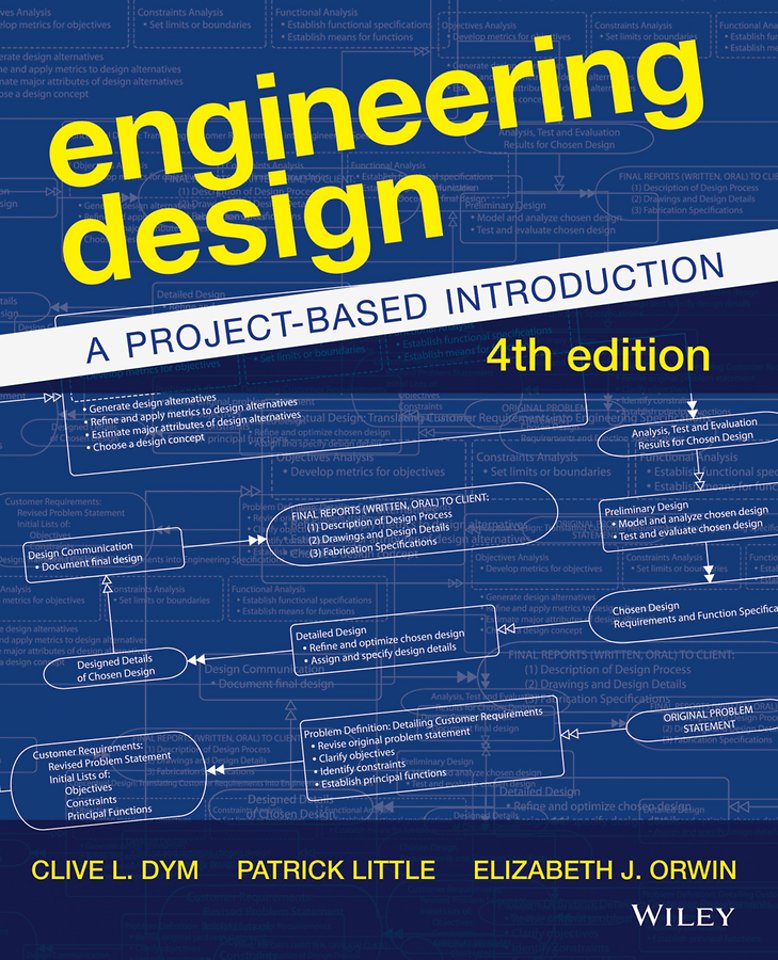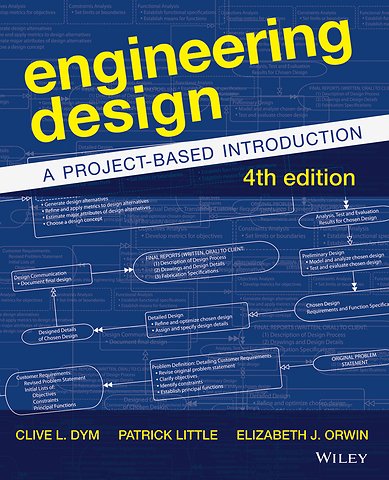Engineering Design
A Project–Based Introduction
Samenvatting
Dym, Little and Orwin′s Engineering Design: A Project–Based Introduction, 4th Edition gets students actively involved with conceptual design methods and project management tools. The book helps students acquire design skills as they experience the activity of design by doing design projects. It is equally suitable for use in project–based first–year courses, formal engineering design courses, and capstone project courses.
Specificaties
Inhoudsopgave
PREFACE xi
ACKNOWLEDGMENTS xvi
PART I INTRODUCTION 1
CHAPTER 1 ENGINEERING DESIGN
What does it mean to design something? Is engineering design different from other kinds of design? 3
1.1 Where and when do engineers design? 3
1.2 A basic vocabulary for engineering design 7
1.3 Learning and doing engineering design 12
1.4 Managing engineering design projects 14
1.5 Notes 15
CHAPTER 2 DEFINING A DESIGN PROCESS AND A CASE STUDY
How do I do engineering design? Can you show me an example? 16
2.1 The design process as a process of questioning 16
2.2 Describing and prescribing a design process 19
2.3 Informing a design process 24
2.4 Case study: Design of a stabilizer for microlaryngeal surgery 27
2.5 Illustrative design examples 34
2.6 Notes 35
PART II THE DESIGN PROCESS AND DESIGN TOOLS 37
CHAPTER 3 PROBLEM DEFINITION: DETAILING CUSTOMER REQUIREMENTS
What does the client require of this design? 39
3.1 Clarifying the initial problem statement 40
3.2 Framing customer requirements 41
3.3 Revised problem statements: Public statements of the design project 43
3.4 Designing an arm support for a CP–afflicted student 44
3.5 Notes 46
CHAPTER 4 PROBLEM DEFINITION: CLARIFYING THE OBJECTIVES
What is this design intended to achieve? 47
4.1 Clarifying a client s objectives 47
4.2 Measurement issues in ordering and evaluating objectives 53
4.3 Rank ordering objectives with pairwise comparison charts 54
4.4 Developing metrics to measure the achievement of objectives 57
4.5 Objectives and metrics for the Danbury arm support 62
4.6 Notes 66
CHAPTER 5 PROBLEM DEFINITION: IDENTIFYING CONSTRAINTS
What are the limits for this design problem? 67
5.1 Identifying and setting the client s limits 67
5.2 Displaying and using constraints 68
5.3 Constraints for the Danbury arm support 69
5.4 Notes 70
CHAPTER 6 PROBLEM DEFINITION: ESTABLISHING FUNCTIONS
How do I express a design s functions in engineering terms? 71
6.1 Establishing functions 71
6.2 Functional analysis: Tools for establishing functions 73
6.3 Design specifications: Specifying functions, features, and behavior 81
6.4 Functions for the Danbury arm support 88
6.5 Notes 91
CHAPTER 7 CONCEPTUAL DESIGN: GENERATING DESIGN ALTERNATIVES
How do I generate or create feasible designs? 92
7.1 Generating the design space, a space of engineering designs 92
7.2 Navigating, expanding, and contracting design spaces 99
7.3 Generating designs for the Danbury arm support 101
7.4 Notes 105
CHAPTER 8 CONCEPTUAL DESIGN: EVALUATING DESIGN ALTERNATIVES AND CHOOSING A DESIGN
Which design should I choose? Which design is best ? 106
8.1 Applying metrics to objectives: Selecting the preferred design 106
8.2 Evaluating designs for the Danbury arm support 111
8.3 Notes 113
PART III DESIGN COMMUNICATION 115
CHAPTER 9 COMMUNICATING DESIGNS GRAPHICALLY
Here s my design; can you make it? 117
9.1 Engineering sketches and drawings speak to many audiences 117
9.2 Sketching 119
9.3 Fabrication specifications: The several forms of engineering drawings 122
9.4 Fabrication specifications: The devil is in the details 127
9.5 Final notes on drawings 129
9.6 Notes 130
CHAPTER 10 PROTOTYPING AND PROOFING THE DESIGN
Here s my design; how well does it work? 131
10.1 Prototypes, models, and proofs of concept 132
10.2 Building models and prototypes 135
10.3 Notes 141
CHAPTER 11 COMMUNICATING DESIGNS ORALLY AND IN WRITING
How do we let our client know about our solutions? 142
11.1 General guidelines for technical communication 143
11.2 Oral presentations: Telling a crowd what s been done 145
11.3 The project report: Writing for the client, not for history 150
11.4 Final report elements for the Danbury arm support 155
11.5 Notes 158
PART IV DESIGN MODELING, ENGINEERING ECONOMICS, AND DESIGN USE 159
CHAPTER 12 MATHEMATICAL MODELING IN DESIGN
Math and physics are very much part of the design process! 161
12.1 Some mathematical habits of thought for design modeling 162
12.2 Some mathematical tools for design modeling 163
12.3 Modeling a battery–powered payload cart 177
12.4 Design modeling of a ladder rung 186
12.5 Preliminary design of a ladder rung 193
12.6 Closing remarks on mathematics, physics, and design 196
12.7 Notes 196
CHAPTER 13 ENGINEERING ECONOMICS IN DESIGN
How much is this going to cost? 197
13.1 Cost estimation: How much does this particular design cost? 197
13.2 The time value of money 201
13.3 Closing considerations on engineering and economics 204
13.4 Notes 204
CHAPTER 14 DESIGN FOR PRODUCTION, USE, AND SUSTAINABILITY
What other factors influence the design process? 205
14.1 Design for production: Can this design be made? 206
14.2 Design for use: How long will this design work? 209
14.3 Design for sustainability: What about the environment? 215
14.4 Notes 218
PART V DESIGN TEAMS, TEAM MANAGEMENT, AND ETHICS IN DESIGN 221
CHAPTER 15 DESIGN TEAM DYNAMICS
We can do this together, as a team! 223
15.1 Forming design teams 223
15.2 Constructive conflict: Enjoying a good fight 227
15.3 Leading design teams 229
15.4 Notes 231
CHAPTER 16 MANAGING A DESIGN PROJECT
What do you want? When do you want it? How much are we going to spend? 232
16.1 Getting started: Establishing the managerial needs of a project 232
16.2 Tools for managing a project s scope 234
16.3 The team calendar: A tool for managing a project s schedule 241
16.4 The budget: A tool for managing a project s spending 243
16.5 Monitoring and controlling projects: Measuring a project s progress 245
16.6 Managing the end of a project 248
16.7 Notes 249
CHAPTER 17 ETHICS IN DESIGN
Design is not just a technical matter 250
17.1 Ethics: Understanding obligations 250
17.2 Codes of ethics: What are our professional obligations? 252
17.3 Obligations may start with the client . . . 255
17.4 . . . But what about the public and the profession? 256
17.5 On engineering practice and the welfare of the public 261
17.6 Ethics: Always a part of engineering practice 263
17.7 Notes 263
APPENDICES 264
APPENDIX A PRACTICAL ASPECTS OF PROTOTYPING 264
APPENDIX B PRACTICAL ASPECTS OF ENGINEERING DRAWING 279
APPENDIX C EXERCISES 300
REFERENCES AND BIBLIOGRAPHY 309
INDEX 315
Vaak samen gekocht
Anderen die dit boek kochten, kochten ook
Net verschenen
Rubrieken
- aanbestedingsrecht
- aansprakelijkheids- en verzekeringsrecht
- accountancy
- algemeen juridisch
- arbeidsrecht
- bank- en effectenrecht
- bestuursrecht
- bouwrecht
- burgerlijk recht en procesrecht
- europees-internationaal recht
- fiscaal recht
- gezondheidsrecht
- insolventierecht
- intellectuele eigendom en ict-recht
- management
- mens en maatschappij
- milieu- en omgevingsrecht
- notarieel recht
- ondernemingsrecht
- pensioenrecht
- personen- en familierecht
- sociale zekerheidsrecht
- staatsrecht
- strafrecht en criminologie
- vastgoed- en huurrecht
- vreemdelingenrecht









